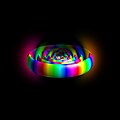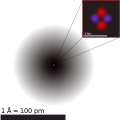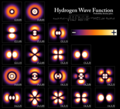physics, a two-electron atom or helium-like ion is a quantum mechanical system consisting of one nucleus with a charge of Ze and just two electrons. This is...
4 KB (499 words) - 16:17, 28 May 2025
A Rydberg atom is an excited atom with one or more electrons that have a very high principal quantum number, n. The higher the value of n, the farther...
51 KB (5,774 words) - 06:45, 25 May 2025
In chemistry and physics, valence electrons are electrons in the outermost shell of an atom, and that can participate in the formation of a chemical bond...
24 KB (2,333 words) - 14:43, 11 June 2025
swarm of electrons. The chemical elements are distinguished from each other by the number of protons that are in their atoms. For example, any atom that contains...
126 KB (12,975 words) - 23:44, 20 June 2025
single hydrogen atom being formed, the acid transfers the hydrogen to H2O, forming H3O+. If instead a hydrogen atom gains a second electron, it becomes an...
39 KB (6,029 words) - 11:56, 21 June 2025
atomic physics and quantum chemistry, the electron configuration is the distribution of electrons of an atom or molecule (or other physical structure)...
60 KB (6,208 words) - 21:30, 15 June 2025
proton-rich nucleus of an electrically neutral atom absorbs an inner atomic electron, usually from the K or L electron shells. This process thereby changes a...
14 KB (1,274 words) - 02:07, 2 March 2025
The electron affinity (Eea) of an atom or molecule is defined as the amount of energy released when an electron attaches to a neutral atom or molecule...
22 KB (1,467 words) - 11:02, 24 April 2025
A three-center two-electron (3c–2e) bond is an electron-deficient chemical bond where three atoms share two electrons. The combination of three atomic...
5 KB (688 words) - 14:16, 30 April 2025
theorized that electrons can perform quantum jumps in 1913. Soon after, James Franck and Gustav Ludwig Hertz proved experimentally that atoms have quantized...
8 KB (868 words) - 11:15, 24 June 2025
along with up and down quarks. Electrons are extremely lightweight particles that orbit the positively charged nucleus of atoms. Their negative charge is balanced...
155 KB (15,851 words) - 08:43, 12 July 2025
A hydrogen-like atom (or hydrogenic atom) is any atom or ion with a single valence electron. These atoms are isoelectronic with hydrogen. Examples of hydrogen-like...
28 KB (5,292 words) - 07:21, 19 June 2025
In chemistry, electron counting is a formalism for assigning a number of valence electrons to individual atoms in a molecule. It is used for classifying...
14 KB (1,629 words) - 18:38, 13 July 2025
Lewis structure (redirect from Electron Dot Structure)
dot structures, electron dot structures, or Lewis electron dot structures (LEDs) – are diagrams that show the bonding between atoms of a molecule, as...
16 KB (2,159 words) - 05:20, 16 May 2025
Atomic orbital (redirect from Orbital atom model)
and wave-like behavior of an electron in an atom. This function describes an electron's charge distribution around the atom's nucleus, and can be used to...
84 KB (10,931 words) - 22:10, 19 June 2025
Atomic physics (redirect from Atom physics)
Atomic physics is the field of physics that studies atoms as an isolated system of electrons and an atomic nucleus. Atomic physics typically refers to...
14 KB (1,714 words) - 20:09, 4 June 2025
The cubical atom was an early atomic model in which electrons were positioned at the eight corners of a cube in a non-polar atom or molecule. This theory...
3 KB (412 words) - 15:19, 26 May 2025
exotic atom is an otherwise normal atom in which one or more sub-atomic particles have been replaced by other particles. For example, electrons may be...
13 KB (1,572 words) - 21:08, 22 June 2025
Covalent bond (redirect from One-electron bond)
chemical bond that involves the sharing of electrons to form electron pairs between atoms. These electron pairs are known as shared pairs or bonding pairs...
29 KB (3,858 words) - 17:32, 1 July 2025
VSEPR theory (redirect from Valence shell electron pair repulsion)
molecules from the number of electron pairs surrounding their central atoms. It is also named the Gillespie-Nyholm theory after its two main developers, Ronald...
45 KB (4,059 words) - 23:30, 1 July 2025
In chemistry, delocalized electrons are electrons in a molecule, ion or solid metal that are not associated with a single atom or a covalent bond. The term...
4 KB (448 words) - 09:16, 12 February 2024
unpaired electron is an electron that occupies an orbital of an atom singly, rather than as part of an electron pair. Each atomic orbital of an atom (specified...
3 KB (420 words) - 09:22, 18 November 2023
Electron (formerly known as Atom Shell) is a free and open-source software framework developed and maintained by OpenJS Foundation. The framework is designed...
24 KB (1,392 words) - 15:40, 22 June 2025
chemistry and atomic physics, an electron shell may be thought of as an orbit that electrons follow around an atom's nucleus. The closest shell to the...
28 KB (2,765 words) - 11:55, 25 April 2025
doping agents used are of two types, resulting in two types of extrinsic semiconductor. An electron donor dopant is an atom which, when incorporated in...
11 KB (1,231 words) - 16:43, 10 June 2025
Core electrons are the electrons in an atom that are not valence electrons and do not participate as directly in chemical bonding. The nucleus and the...
10 KB (1,397 words) - 05:55, 19 June 2025
Hund's rule of maximum multiplicity (section Atoms)
predict the ground state of an atom or molecule with one or more open electronic shells. The rule states that for a given electron configuration, the lowest...
6 KB (787 words) - 18:09, 11 July 2025
Plum pudding model (redirect from Atom/plum pudding)
obsolete scientific model of the atom. It was first proposed by J. J. Thomson in 1904 following his discovery of the electron in 1897, and was rendered obsolete...
43 KB (6,145 words) - 07:43, 24 May 2025
relative electronegativity of the two atoms forming the bond. The electron cloud in a σ-bond between two unlike atoms is not uniform and is slightly displaced...
11 KB (1,381 words) - 15:57, 22 April 2025
coordinate bond is a kind of two-center, two-electron covalent bond in which the two electrons derive from the same atom. The bonding of metal ions to...
10 KB (1,310 words) - 15:12, 21 May 2025
















